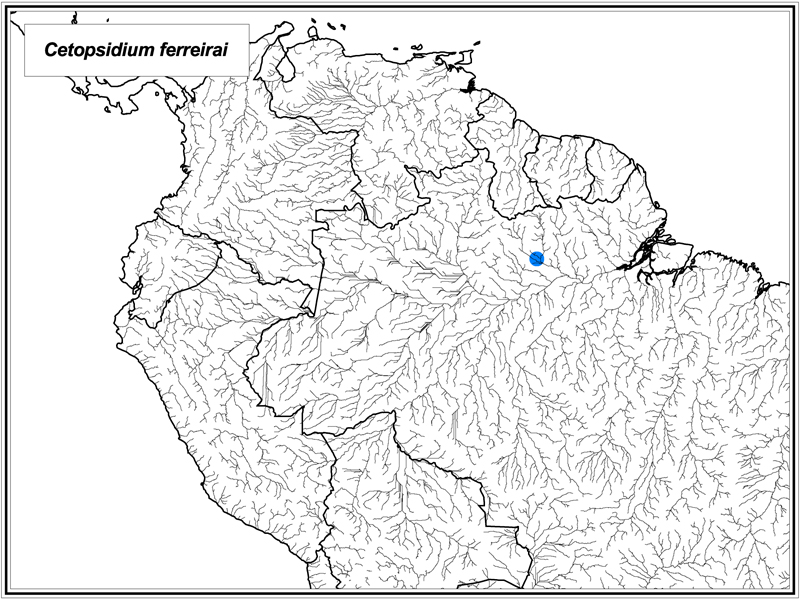
Reproduced from Vari, Ferraris and de Pinna (2005).
Cetopsidium ferreirai Vari, Ferraris & de Pinna, 2005
Identification: Cetopsidium ferreirai differs from all of its congeners with the possible exception of C. roae and C. minutum (see those species accounts) in the lack of distal filaments on the first rays of the dorsal and pectoral fins in adult males (versus the presence of such filaments in adult males as indicated by the possession of distinctly convex anal-fin margins, respectively). Cetopsidium ferreiraifurther differs from C. minutum in the length of the pelvic fin (falling short of anal-fin origin versus extending at least to anal-fin origin, respectively). Cetopsidium ferreirai further differs from C. morenoiin the overall form of the head (the head being not massive proportionally as a consequence of the less extensive development of the adductor mandibulae muscle onto the dorsal surface of head and with the snout distinctly rounded versus the head being proportionally massive with well-developed distinctly bulging adductor mandibulae muscles and the snout less rounded, respectively), and the less extensive dark pigmentation on the body (the near absence of dark pigmentation on the lateral surface of body and the pigmentation limited to the middorsal region of body versus the dark pigmentation being distributed over much of the lateral and dorsal surfaces of the body, respectively). Cetopsidium ferreirai further differs from C. orientale in the alignment of the dorsal and ventral profiles of the portion of the body posterior of the base of the dorsal fin (profiles converging posteriorly versus running in parallel, respectively) and in the overall coloration (limited dark pigmentation located largely along the middorsal region of the body versus dark pigmentation widely distributed over the dorsal and lateral portions of body, respectively). Cetopsidium ferreirai further differs from C. pemon in the overall form of the head (profile of head anteriorly rounded versus distinctly pointed, respectively) and in the proportional length of the snout (approximately 2 times diameter of the eye versus approximately 3 times diameter of the eye, respectively). Cetopsidium ferreirai further differs from C. roae in the position of the vent (proximate to the base of the anterior most anal-fin ray versus distinctly separated from the base of the anterior most anal-fin ray, respectively). Maximum size: 37 mm SL.
Range: Cetopsidium ferreirai is known only from the Rio Trombetas, a left bank tributary of the lower Rio Amazonas.
Information from Vari, R. P., C. J. Ferraris Jr. & M. C. C. de Pinna. 2005. The Neotropical whale catfishes (Siluriformes: Cetopsidae: Cetopsinae), a revisionary study. Neotropical Ichthyology 3:127-238.
